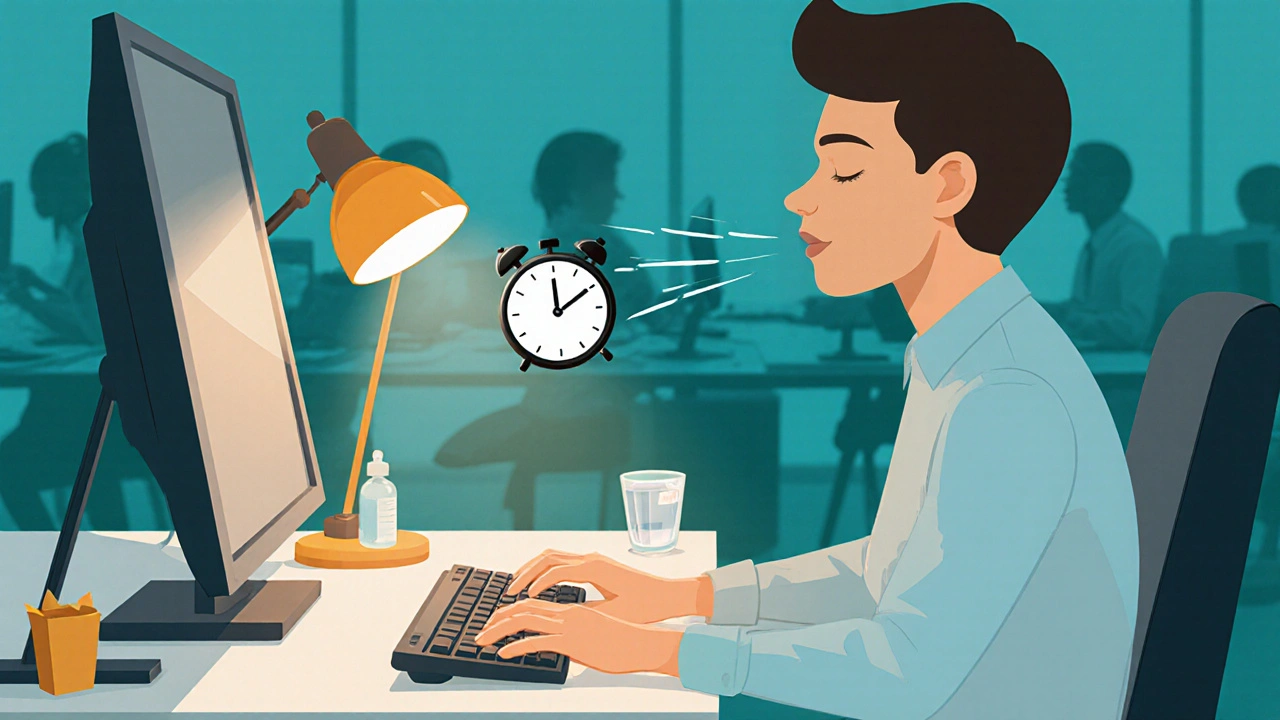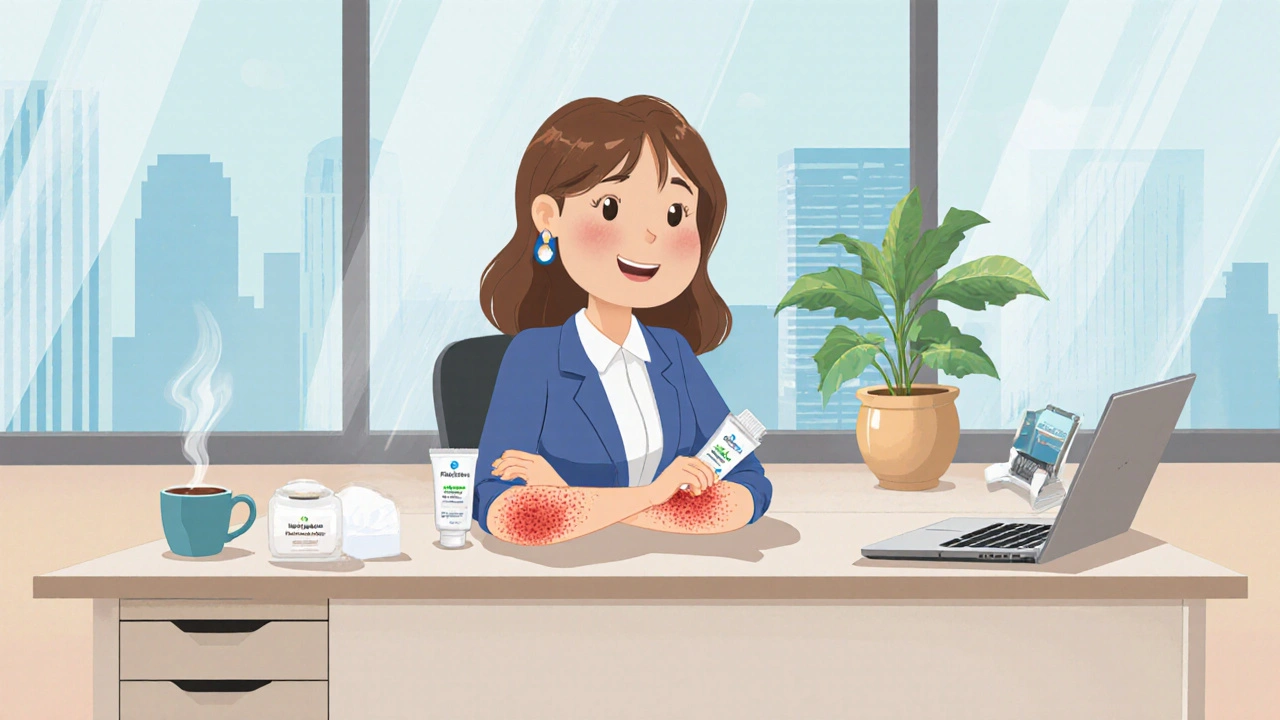Psoriasis Workplace Trigger Identifier
Identify Your Triggers
Personalized Management Plan
Recommended Actions
Key Takeaways
- Identify triggers that make psoriasis flare at the office.
- Use discreet skin‑care routines that fit into a busy day.
- Apply stress‑busting techniques you can do right at your desk.
- Know your legal rights and the benefits you can tap into.
- Create a simple daily checklist to keep comfort high and stress low.
Living with Psoriasis is a chronic autoimmune skin condition that causes red, scaly patches, often on elbows, knees, scalp, and lower back. It’s not just a skin issue-flare‑ups can spike anxiety, affect concentration, and make a typical 9‑to‑5 feel impossible. The good news? A mix of smart skin‑care, workplace tweaks, and stress‑reduction habits can keep you productive without sacrificing comfort.
Understanding Psoriasis in the Office
First, know that psoriasis isn’t contagious. Most people with the condition experience periods of calm followed by sudden flare‑ups triggered by a handful of common factors:
- Cold, dry air that dries out the skin barrier.
- Prolonged sitting or pressure on joints, which can worsen scalp and back plaques.
- Stressful meetings, tight deadlines, or high‑stakes presentations.
- Certain foods-processed carbs, dairy, and alcohol-can aggravate inflammation for some.
When you spot a trigger, you can act before the irritation spreads across the office chair.
Managing Flare‑Ups During Work Hours
Most workplaces have a bathroom, a break room, and a desk. Use those spaces strategically.
Topical Steroids are a first‑line treatment that reduces inflammation in minutes. Keep a small tube in a discreet drawer-just a pea‑sized amount enough for a quick touch‑up before a client call.
If your dermatologist prescribed Biologic Therapy, schedule the injection during a lunch break or after work. These meds target the immune response itself, offering longer‑term control so you’re less likely to scramble for a rescue cream mid‑meeting.
For those who prefer light‑based options, UV Light Therapy can be done at a clinic twice a week. Talk to your HR about flexible scheduling; many firms allow a half‑day for medical appointments.
Stress‑Reduction Strategies that Fit the Desk
Stress is a hidden flare‑up driver. You don’t need a meditation retreat to lower cortisol-simple habits woven into the workday do the trick.
- Box‑breathing: Inhale for four seconds, hold for four, exhale for four, hold for four. Do it twice a day, especially before a presentation.
- Micro‑stretch breaks: Stand, roll shoulders, and gently stretch arms every hour. Use a timer or a reminder app.
- Desk‑bound mindfulness: Close your eyes, focus on the sensation of your hands on the keyboard for 30 seconds. It grounds you without leaving the workstation.
- Personal music playlist: Instrumental tracks at a low volume can mask office noise and calm the nervous system.
These low‑effort practices lower stress hormones, which in turn reduces the chance of a sudden skin flare.

Skin‑Care Routine that Works on the Job
Keeping the skin barrier intact is the foundation of comfort.
- Moisturize immediately after washing: Choose a fragrance‑free ointment like petrolatum or a ceramide‑rich cream. Apply while skin is still damp for best absorption.
- Hydrate hands: Use a small tube of hand cream that dries quickly and doesn’t leave a greasy residue on keyboards.
- Sun protection indoors: Some office lighting can emit UV‑A. A lightweight, non‑comedogenic SPF 30 lotion protects against incidental exposure.
- Clothing choices: Soft, breathable fabrics (cotton, bamboo) reduce friction. If dress code allows, opt for loose‑fit shirts and avoid tight cuffs.
Keep a mini‑kit in a drawer: moisturizer, a tube of Topical Steroids, and a small pack of hypoallergenic wipes.
Communicating with Employers and HR
Transparency can unlock accommodations you might not even know exist.
When you’re ready to discuss, follow these steps:
- Schedule a private meeting with HR or your manager.
- Explain psoriasis in plain language: it’s a chronic condition, not contagious, and can be managed with simple workplace tweaks.
- Request specific accommodations, such as:
- A flexible break schedule for medication or moisturising.
- Permission to keep personal skin‑care items at your desk.
- Adjustments to lighting (e.g., a desk lamp with a warm hue).
- Offer to provide a note from your dermatologist if needed.
Many companies have an Employee Assistance Program (EAP) that includes counseling and stress‑management resources. Ask whether you can access those services without extra cost.
Leveraging Benefits and Support Programs
Understanding what your health plan covers can save money and time.
- Prescription coverage: Verify if your plan pays for biologics, topical steroids, or phototherapy sessions.
- Telehealth visits: Some insurers allow virtual dermatology appointments, letting you adjust treatment without a day off.
- Wellness incentives: Companies sometimes offer points or reimbursements for health‑related purchases-ask if skin‑care products qualify.
Document all communications and keep a folder (digital or paper) of medical notes, insurance statements, and accommodation approvals.

Quick Checklist for Daily Comfort
- Morning: Wash face with gentle cleanser, apply moisturizer while skin is damp.
- Before work: Pack a small kit (moisturizer, topical steroid, wipes).
- Mid‑morning: Take a 2‑minute box‑breathing break.
- Lunch: If on biologic therapy, schedule injection; otherwise, stretch and hydrate.
- Afternoon: Re‑apply moisturizer if office air feels dry.
- End of day: Quick skin inspection, note any new spots, and log them for your dermatologist.
Comparison of Common Workplace‑Friendly Treatments
| Option | Onset of Relief | Administration | Typical Side‑Effects | Workplace Flexibility |
|---|---|---|---|---|
| Topical Steroids | Minutes‑hours | Apply to affected area | Skin thinning with long‑term use | Very high - discreet tube fits desk drawer |
| Biologic Therapy | Weeks | Injection (weekly/bi‑weekly) | Risk of infection, mild flu‑like symptoms | High - schedule during lunch or after work |
| UV Light Therapy | Days‑weeks | Clinic sessions (2‑3 times/week) | Skin redness, rare burns | Medium - requires appointment time off |
Final Thoughts
Managing psoriasis workplace challenges isn’t about a single miracle cure; it’s about building a routine that blends medical treatment, smart environmental tweaks, and stress‑busting habits. By knowing your triggers, keeping a discreet skin‑care kit, and having open conversations with your employer, you can stay productive and comfortable every day.
Frequently Asked Questions
Can I keep my psoriasis medication at my desk?
Yes. Most topical treatments come in small tubes that fit easily into a desk drawer. Just follow your office’s policy on personal items and keep them out of sight if you prefer.
What legal protections do I have for psoriasis at work?
In the U.S., psoriasis is considered a disability under the Americans with Disabilities Act (ADA) when it substantially limits major life activities. This means employers must provide reasonable accommodations, such as flexible break times or ergonomic adjustments.
How often should I moisturize during a workday?
Ideally after each hand‑washing session and at least once in the morning. If the office air is very dry, a quick re‑apply mid‑afternoon can keep the skin barrier intact.
Are there diet changes that help at work?
While diet effects vary, many people see improvement by reducing processed carbs, limiting dairy, and avoiding excess alcohol. Keep healthy snacks like nuts or fruit at your desk to avoid spike‑inducing meals.
What should I do if a flare‑up happens during a meeting?
Excuse yourself briefly, apply a thin layer of your topical steroid, and re‑hydrate the skin. Most colleagues won’t notice, and a quick break often helps you refocus.


11 Comments
Winston Bar
Great, another article telling us to breathe at work.
Steve Holmes
Hey folks, love the vibe here, and let’s add a quick tip: keep a tiny bottle of fragrance‑free ointment in your desk drawer, it’s a game‑changer, especially before that big call! Also, set a gentle reminder on your phone for a two‑minute box‑breathing break every three hours, it’ll keep cortisol in check, and the habit becomes second nature! Don’t forget to moisturize right after hand‑washing – the skin absorbs best while it’s still damp, so a dab of ceramide cream does wonders, trust me! Lastly, try swapping the office thermostat a notch higher if the air feels bone‑dry, a humidifier at your workstation can save a lot of flare‑ups, and it’s totally doable!
Tom Green
What you’re describing is a classic case of “work‑day skin management.” The key is to blend treatment with routine, so the extra steps feel natural. Keep a miniature kit – moisturizer, steroid tube, and a pack of hypoallergenic wipes – in a discreet desk drawer; that way you never scramble during a meeting. Pair each application with a micro‑stretch, and you’ll notice less tension propagating to your joints, which often fuels plaques. Over time, this habit forms a protective barrier, both physically and mentally.
Emily Rankin
Imagine the office as a stage where the spotlight shines not only on the project but also on the skin that tells a story of resilience. Every breath you take, every pause you make, is a stanza in a poem of self‑care; the cadence of box‑breathing becomes a drumbeat that quiets the inner storm. When the fluorescent lights glare, picture them as embers of sunrise, softened by a gentle lamp you choose yourself. The act of moisturizing is not mere routine; it is an act of love, a ceremonial seal against the world’s harsh whispers. Let the scent‑free ointment glide like a whispered promise, and feel the drama of irritation dissolve into calm. In this theater of work, you are both the director and the lead, and each mindful moment rewrites the script toward comfort.
Rebecca Mitchell
Honestly you just need a tiny pot of cream on your desk it won’t bother anyone. Keep it hidden if you’re shy.
Roberta Makaravage
First, let me state the obvious: psoriasis is not a personal failing, it is a medically documented autoimmune disorder, and any workplace that treats it as a nuisance is ethically bankrupt 😡. Second, the notion that a simple moisturizer will “cure” the condition betrays a profound ignorance of dermatological science, as if a band‑aid could stop a flood 🌊. Third, the legal framework in the United States, namely the Americans with Disabilities Act, explicitly requires reasonable accommodations for chronic conditions, and that includes flexible break times for medication administration 🙏. Fourth, a discreet skin‑care kit-containing a fragrance‑free ointment, a steroid tube, and hypoallergenic wipes-should be considered essential equipment, not a luxury. Fifth, the modern office environment is rife with triggers: low humidity, artificial lighting, and relentless stress, all of which can be mitigated with simple adjustments like portable humidifiers and warm‑tone desk lamps. Sixth, employees should educate their HR departments about the existence of UV‑A emissions from certain fluorescent bulbs, demanding replacement with full‑spectrum lighting. Seventh, if an employer refuses reasonable accommodations, the employee has the right to file a claim with the Equal Employment Opportunity Commission, and many legal precedents support such actions. Eighth, the psychological burden of hiding a visible condition can be as damaging as the physical symptoms, thus mental‑health support through Employee Assistance Programs is not optional, it is mandatory. Ninth, telehealth services have revolutionized dermatology access, allowing patients to adjust treatment plans without sacrificing work hours, which should be encouraged by corporate wellness budgets. Tenth, the stigma surrounding skin conditions often stems from antiquated myths that equate visible lesions with contagion, a belief that modern medicine has long debunked. Eleventh, fostering an inclusive culture starts with leadership openly acknowledging diverse health needs, thereby dismantling the culture of silence. Twelfth, the act of regularly applying a prescribed topical steroid is a medical necessity, not a cosmetic indulgence, and should be scheduled during lunch or designated break periods. Thirteenth, many insurance plans now cover biologic therapies that dramatically reduce flare‑ups, removing the need for frequent on‑site interventions. Fourteenth, individuals should keep a digital log of flare‑up occurrences, treatments applied, and potential triggers, which empowers both the patient and the healthcare provider. Fifteenth, educating coworkers about psoriasis can reduce unfounded rumors and promote empathy, turning a potentially hostile environment into a supportive community. Finally, remember that the pursuit of a comfortable workday is a right, not a favor, and every successful accommodation sets a precedent that benefits future employees with chronic conditions 😊.
Lauren Sproule
Hey i think keepng a tiny tube of cream in your desk is super helpful it doesnt draw any attention lol. Also try a quick stretch every hour it really helps the joints and skin. stay comfy and keep sharing tips
CHIRAG AGARWAL
Honestly this whole “desk routine” thing is overhyped we all have enough stress already. Just get a decent cream and move on.
genevieve gaudet
In many cultures skin is seen as a living map, each patch tells a story of ancestors and modern life. When we ignore that narrative at work we lose an important piece of identity. So blending care with culture makes the day feel richer. Keep that in mind when you set your desk kit.
Patricia Echegaray
They don’t tell you that big pharma profits off every flare‑up, pushing us to buy endless creams while the real cure is hidden by corporate lobbyists. The government’s “ADA” safeguards are just a smokescreen, designed to keep the workforce compliant but never truly free. Our offices are battlegrounds where fluorescent lights act like covert weapons, draining energy and amplifying inflammation. If you want real relief you must look beyond the sanctioned meds and demand transparency from the board. Wake up, question the narrative, and take control of your skin destiny.
Miriam Rahel
It is imperative to acknowledge that the recommendations presented herein align with prevailing dermatological consensus, yet the omission of precise dosage parameters warrants scrutiny. Moreover, the suggestion to employ a “mini‑kit” neglects the variability in topical potency across pharmaceutical brands, a nuance that seasoned clinicians cannot overlook. While the stress‑reduction techniques are commendable, their efficacy is contingent upon individualized psychophysiological profiles, a factor often disregarded in generic advice. Consequently, practitioners are advised to tailor interventions to each patient’s unique clinical presentation to ensure optimal outcomes.